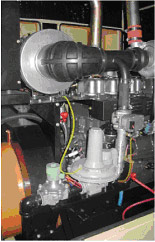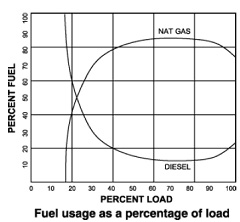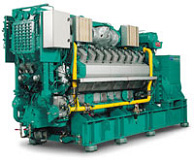Power Quality and Generators - Part 4: Fuel Configurations for Standby Gensets
Editor's Note
This is the fourth installment in an ongoing series that will cover basic engineering and code issues for standby generators. In a subsequent column, the author will address paralleling generators.
This month's column covers various alternative fuel configurations that can be used for standby generators. We'll also review the National Electrical Code (NEC) requirements for on-site fuel supplies and concerns over liquid petroleum storage and gas piping.
Fuel options
In my experience, when a typical commercial building or critical infrastructure uses a standby generator, it is most often diesel-driven. As long as a diesel engine is kept warm when not in operation, starting reliability is very good.
There are other sources of fuel that can be utilized to power a standby generator. Some of these sources include:
- Natural gas only
- Natural gas and propane
- Lean burn
- Natural gas and diesel combination
In all cases, if the generator will feed life-safety loads, it must comply with NEC requirements for an on-site fuel supply. NEC Section 700.12(B)2, "Internal Combustion as Prime Mover," indicates that where an internal combustion engine is used as the prime mover for an emergency generator to feed life-safety loads, the system shall be provided with an on-premises fuel supply sufficient for not less than two hours of the system at full-load amps. If a natural gas generator is designed to feed life-safety loads, it will also require two hours of on-premises fuel source. This requirement can be met with either a propane or diesel supply.

Here, one sees the natural gas supply line on the bi-fuel generator. (Courtesy: Generac)
Natural gas alone will not comply with the NEC, with one exception: 700.12 (B) (3), which states "Where acceptable to the authority having jurisdiction, the use of other than on-site fuels shall be permitted where there is a low probability of a simultaneous failure of both the off-site fuel delivery system and power from the outside electrical utility company." For the full text, see here.
The issue of non-compliance is due to the fact that natural gas is piped by the serving utility from their distribution system to the generator. A regulator is typically required to reduce the gas pressure at the generator to safe working levels. A solenoid valve controls the flow of gas to the regulator and generator carburetor. There is no actual on-premises storage of fuel when the natural gas is supplied by the utility.
The downside of only using natural gas is obvious: In the event of a disaster, such as an earthquake, at a time when you need the standby generator the most, the natural gas fuel line could be ruptured, rendering the generator useless. A standby source of propane or diesel would be necessary.
Bi-fuel and feasibility
Environmental concerns, clean air legislation and operating costs of diesel generators have increased the interest in bi-fuel products. A dual-fuel generator capable of burning diesel and natural gas can be advantageous, because its exhaust is less toxic then diesel.
However, the difficulty with this strategy is in maintaining the best possible balance of diesel and natural gas throughout the power range of the load. This regulation process must be maintained in an environment of potentially changing ambient temperatures. With newer technology, advanced microprocessor controls have improved this process.
But keep in mind that at no time can the diesel and natural gas combination generator operate purely on natural gas (unless the exception mentioned above is met). Some of the diesel fuel is required for compression ignition. Natural gas has a much higher ignition temperature than diesel. During the startup, the system runs on 100% diesel fuel.
After startup, the system brings in more natural gas with the air intake. At the same time, the amount of diesel fuel is reduced. This whole process is monitored with the actual load requirements and ambient temperature to ensure the correct mix of fuels. The optimal bi-fuel ratio under normal operation is a 10% diesel and 90% natural gas mix. Under these conditions, a smaller amount of diesel fuel would be required to meet the two hours of standby fuel requirements.
On the other hand, the same amount of diesel fuel could operate a building significantly longer than two hours. One study describes an example of a 300-kW generator loaded 80% to 240 kW with a 183-gal diesel tank having a diesel only runtime of 8.9 hours (see Generac website). The bi-fuel run time was extended to 76.2 hours or 3.2 days. This extended run time is a clear advantage in an extended power outage. In addition, the bi-fuel technology reduces the exhaust emissions.
Lean burn technology

Here, the graph indicates the percentage of load and the percent usage of natural gas and diesel fuel. (Courtesy: Generac)
Another technology utilizes what is referred to as "lean burn." This technology allows the engine to run on a wide range of gasses, including natural gas, field gas or bio-gas. Any gas with a methane number of 50 can be used. De-rating of the generator output may be required if utilizing a gas with a methane number of below 70.
This system can be utilized with a propane tank at the generator as the standby source and comply with NEC requirements. This system also reduces the emissions of NOx and other pollutants.
Optimizing operation
Some gasses can contain unacceptable levels of higher hydrocarbons and hydrogen sulfide. Use of gas with a low methane number can cause operating problems and lead to increased maintenance costs and downtime.
When utilizing a natural gas and propane unit, either of the gasses can be utilized. These gasses are not mixed as they are in the diesel and natural gas combination units.
In a natural gas and LP vapor dual-fuel system, the natural gas supply pressure is monitored. When the pressure of the natural gas supply drops below a preset threshold, the natural gas solenoid valve is closed and the LP vapor solenoid valve is opened. The generator is then served by the LP vapor.
Vapor propane systems draw the fuel from the top of the tank. The liquid in the bottom of the tank must absorb enough heat energy for the vaporization process to occur. Very cold climates can cause poor fuel flow. A liquid withdrawal system eliminates this process.
A liquid propane tank should not be installed inside a building. The LP tank should be installed outside away from electrical connection sparks or open flames.
Fuel consumption estimates

Fuel consumption on propane at full load is about 40 gal per hour for a 331-kW unit. This would equate to about 80 gal for NEC required two hours of fuel, 320 gal for 8 hours and 1,000 gal for 25 hours.
The engineer must coordinate with the local electrical plan reviewer and fire marshal to ensure that all codes referencing on-site fuel storage and gas piping are followed prior to construction.
Fuel cells
Finally, no review of alternative fuels would be complete without a discussion of fuel cells. A fuel cell can provide direct current voltage that can be used to power devices. Current technology will allow a proton exchange membrane fuel cell the size of a piece of luggage to power a car.
Fuel cells for homes and commercial use are just starting to become available. This technology can utilize methanol, natural gas, and propane as the fuel source. Issues such as hydrogen infrastructure and life of the fuel cell need to be addressed and improved before this technology becomes more widespread.
Articles in This Series
- Part 1: Sizing and Code Issues
- Part 2: The Effects of Harmonics
- Part 3: Complying with the Codes and Controlling Noise
- Part 4: Fuel Configurations for Standby Gensets
- Part 5: Paralleling Generators in Critical Applications
- Part 6: Generator Sizing and UPS
- Part 7: Commissioning, Training and Long-Term O&M Programs
- Part 8: Basic Calculations for Sizing Generators and the Impacts of Certain Loads
- Part 9: Design Criteria for Grounding
- Part 10: Generators and the 2005 NEC